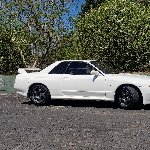R32 Gtr Single Gt35r. Apexi's De-jetro A Good Choice?
Announcements
-
Similar Content
-
Latest Posts
-
Unfortunately, it feels like it's been on the decline for nearly a decade. Especially as wallet racing became popular with them(biggest wallet can pay off a car that wins). It seems like a different mindset kf ownership these days. But, hopefully people like yourself keep some of the skyline scene alive.
-
By Dose Pipe Sutututu · Posted
A bit of data is always good, beats the Facebook experts with their opinions Although the kWs aren't anywhere near what you are after, it should give you a good indication. I have Bosch 1480cc injectors, often called 1650cc (only when run at 4bar). I run mine at 3bar base so I don't thrash the fuel system. Up top, making 437kW with boost dropping, injector duty is at 69% on E80 (might have had some residual 98RON in there) -
By TurboTapin · Posted
I have some downtime due to winter, and just wrapped up converting the car over to flex fuel. We don't get E85 at the pump over here in Canada, but I will be running Ignite E90 Race gas. I'll be mixing it with 99-100 RON pump gas and shoot for 50% ethanol content, up to possibly 85% content if there's any noticeable gains. Here's the question. Most I'll ever want to hit is ~600rwkW. I've currently running 1200cc injectors and want to keep them under 90% duty cycle. As per some online injector calculators, I should be good with 1200's well past 600rwkw on E85. As per other calculators, I'll need 1600-2000cc's. The variety is rather amusing. With you Australians having E85 at the pump, what realistic duty cycles are you seeing in those kW ranges on E50 & E85 on your injectors? Thanks, -
By TurboTapin · Posted
No issues here with my PRP gears in an OEM pump housing. I did confirm all housing clearances were to spec prior though. Cheers. -
Thread is a bit old but figured id give my input anyway just incase. Have had lots of water problems in my R32 and was getting sick of wet tools in the boot and water filling up half my taillights. I ended up finding that whenever my car had been repainted they didn't reseal the taillights to the body of the car so water was just flowing straight into the boot, this is amplified by all the water around the bootlid being directed down to the taillights so would get pretty wet whenever I washed the car or it rained. You could probably use silicone to seal them to the body but I think from factory they use a roll of automotive grade butyl rubber. Hopefully this helps you if that ends up being how the water is getting in on your car!
-









Recommended Posts
Create an account or sign in to comment
You need to be a member in order to leave a comment
Create an account
Sign up for a new account in our community. It's easy!
Register a new accountSign in
Already have an account? Sign in here.
Sign In Now